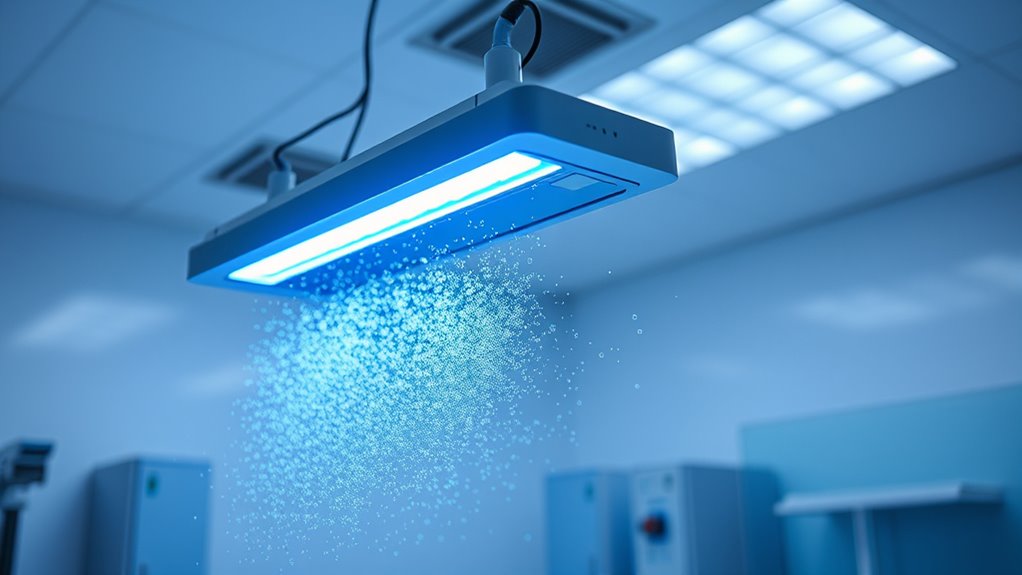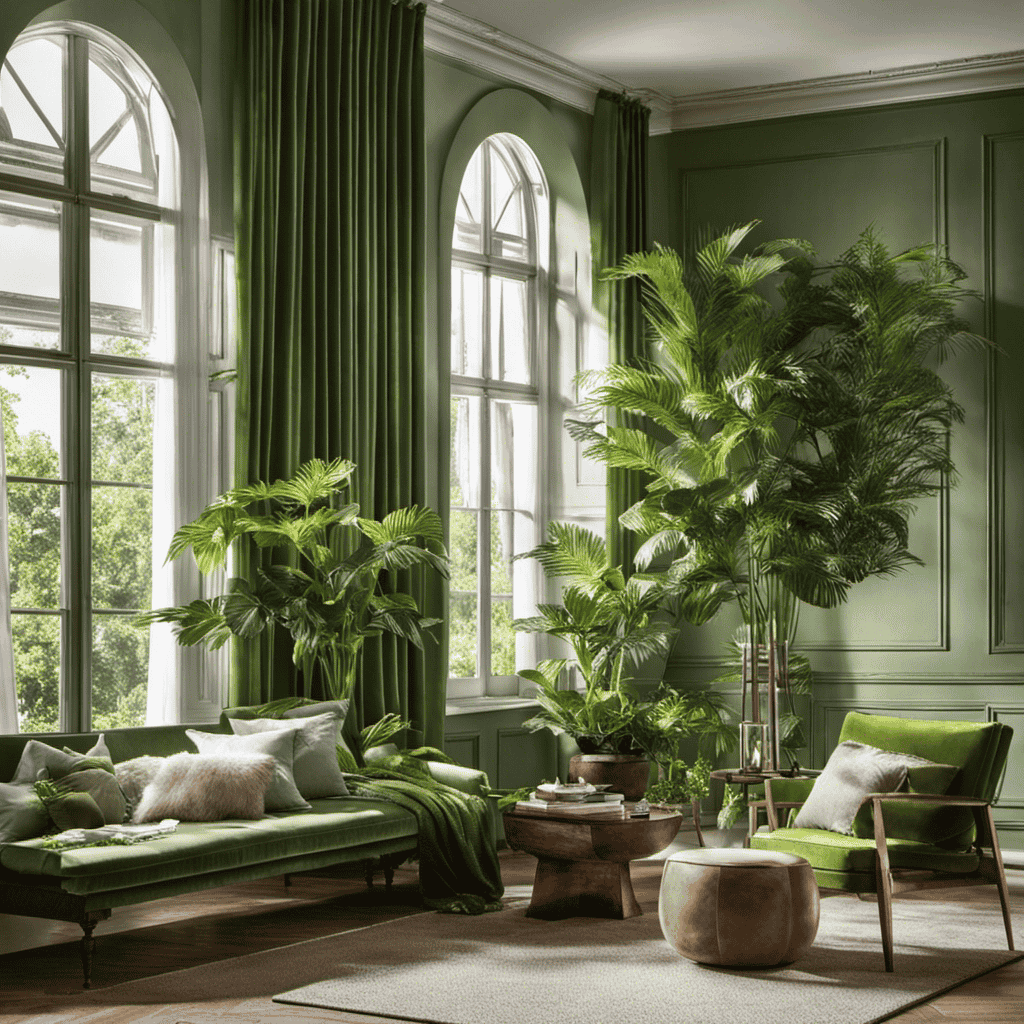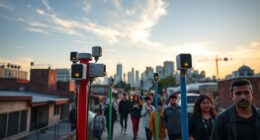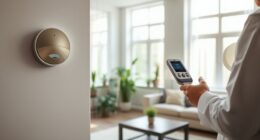UV-C lamps can effectively kill airborne viruses by damaging their genetic material, stopping them from replicating or causing infections. When properly installed and maintained, UV-C light inactivates pathogens passing through the air, especially in well-designed systems like HVAC units. Keep in mind that their effectiveness depends on factors like intensity, exposure time, and safety precautions. To discover how these systems work together for improved indoor air safety, keep exploring further details.
Key Takeaways
- UV-C lamps emit ultraviolet light that damages microbial DNA or RNA, preventing replication and inactivation of airborne viruses.
- Properly installed UV-C devices within airflow systems can effectively target airborne viruses passing through the light.
- Effectiveness depends on UV-C intensity, exposure time, and direct line of sight to the microorganisms.
- UV-C lamps should be used alongside other methods like filtration and cleaning for comprehensive air safety.
- When used correctly, UV-C lamps significantly reduce airborne virus levels, enhancing indoor health protection.

UV-C lamps have become a popular tool for reducing airborne viruses, especially in indoor environments. They leverage UV C technology to help improve air purification, making the air safer to breathe in crowded or enclosed spaces. These lamps emit ultraviolet light at specific wavelengths that can damage the genetic material of microorganisms, including viruses, bacteria, and fungi. When properly used, UV-C air purification systems can considerably decrease the number of airborne pathogens, providing an extra layer of protection for building occupants.
UV-C lamps effectively reduce airborne viruses, enhancing indoor air safety through targeted ultraviolet light technology.
The core principle behind UV-C technology is its ability to disrupt the DNA or RNA of microorganisms. When airborne viruses pass through the UV-C light, their genetic material absorbs the radiation, rendering them unable to replicate or cause infection. This process is fast and effective, especially when the UV-C lamps are positioned correctly in the airflow of HVAC systems or in standalone air purifiers. By continuously exposing the air to UV-C radiation, you can reduce the overall viral load circulating indoors.
However, it’s essential to understand that UV-C lamps are not a magical solution that instantly sterilizes an entire space. Their effectiveness depends on several factors: the intensity of the UV-C light, exposure time, air circulation, and direct line of sight. Proper installation and maintenance are critical to ensure the lamps deliver the intended results. For example, UV-C lamps installed within HVAC ducts need to be carefully aligned so that all passing air receives adequate irradiation. Similarly, portable air purifiers with UV-C components should be used in conjunction with other air cleaning methods, like filtration, to maximize air purification.
Safety is another key consideration. UV-C light can be harmful to skin and eyes, so it’s vital to use UV-C air purification devices that are designed with safety features, such as enclosed bulbs or automatic shut-offs when opened. Never look directly at a UV-C lamp while it’s operating, and always follow the manufacturer’s instructions for installation and use.
While UV-C lamps are effective at inactivating airborne viruses, they don’t replace traditional cleaning or filtration methods. Combining UV-C technology with HEPA filters enhances overall air purification, ensuring a cleaner, healthier indoor environment. Additionally, ongoing research into AI Safety is crucial to understanding and mitigating potential vulnerabilities associated with UV-C and other safety-critical technologies. When integrated properly, UV-C lamps serve as a valuable tool in your efforts to reduce airborne viruses, giving you greater confidence in the safety of indoor spaces. With the right approach, UV-C technology can be a powerful ally in maintaining healthier air quality.
Frequently Asked Questions
How Long Does It Take for UV-C Lamps to Disinfect a Room?
The room sterilization time with UV-C lamps varies based on the lamp’s power, room size, and air circulation. Typically, you’ll see UV-C efficacy within 10 to 30 minutes for small to medium spaces. For larger rooms, it may take up to an hour. To guarantee effective disinfection, follow manufacturer guidelines, and consider factors like airflow, which influence UV-C’s ability to neutralize airborne viruses during the process.
Are UV-C Lamps Safe for Continuous Human Exposure?
You might wonder about UV-C safety with continuous exposure. Generally, UV-C lamps are not safe for direct, prolonged human exposure because they can cause skin burns and eye injuries. Manufacturers recommend using UV-C devices in unoccupied spaces or with proper shielding. For continuous exposure, it’s essential to follow safety guidelines to prevent health risks. Always guarantee the UV-C system is designed with safety features to protect users during operation.
Do UV-C Lamps Work on All Types of Airborne Viruses?
Imagine UV-C lamps as vigilant guardians, but their effectiveness varies with each virus. You should know that virus susceptibility differs, so lamp effectiveness isn’t universal. Some airborne viruses are more vulnerable, while others resist UV-C light. To maximize protection, choose lamps proven to target specific viruses. Remember, understanding each virus’s susceptibility helps you decide if UV-C technology offers reliable defense against airborne threats.
Can UV-C Lamps Eliminate Odors Along With Viruses?
UV-C lamps primarily target airborne viruses, but they can also aid in odor elimination as part of air purification. When installed correctly, UV-C light breaks down odor-causing molecules, reducing unpleasant smells. This dual function makes UV-C lamps useful for improving indoor air quality, as they help eliminate airborne pathogens and odors simultaneously, creating a fresher and healthier environment. Just guarantee proper placement and safety measures for effective results.
What Are the Maintenance Requirements for UV-C Air Sterilization Systems?
Think of your UV-C air sterilization system as a diligent guard, always on duty. To keep it effective, you need to monitor the lamp lifespan and perform regular replacement procedures. Typically, lamps last around 9,000 to 12,000 hours, depending on the model. Check manufacturer guidelines for specific intervals, and replace the lamps promptly to guarantee maximum sterilization. Regular maintenance keeps your air clean and your system working like a well-oiled machine.
Conclusion
UV-C lamps can help reduce airborne viruses, but they aren’t a foolproof solution. They kill viruses on surfaces, in the air, and around you—if used correctly. They protect your space, but don’t replace other safety measures. They are a tool, a supplement, a safeguard. Use them wisely, maintain good hygiene, and follow guidelines. Because when it comes to airborne viruses, combining efforts is your best defense—protect yourself, protect others, and stay safe.










